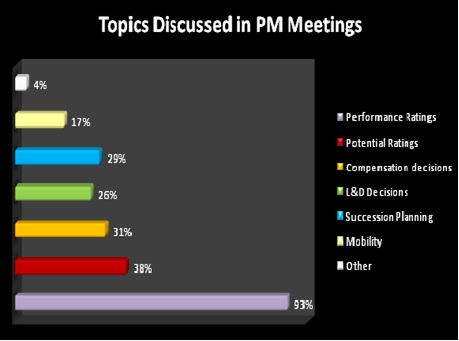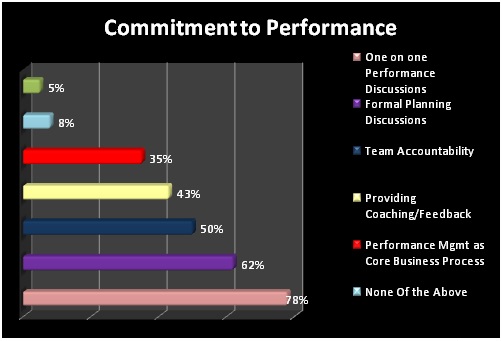
A healthy organization is one which has a balance between happy external and internal customers. For an organization to be productive it must have a happy customer base and for that to happen, they must have a happy workforce. How does one achieve that?
Everybody is aware of the carrot stick approach which we are so used to in almost all organizations. Using a combination of rewards and punishments to reinforce a behavior or to accomplish a goal has always been the norm in companies. This approach of rewarding and punishing leaves half of the workforce happy and leaves the other half unhappy and demotivated.
Many of them believe it to be performance management. But is that all this term means?
Performance Management-The process in brief
A good performance management process involves not just rewarding the employees for good work, but also retaining them by strategically planning for their development and career growth. It basically constitutes these 4 stages.
- Planning: It starts with understanding the skill set and the interest of employees and mapping it with the job. The management must ensure that there is a job fit amongst all its employees. Sometimes, management tends to promote its employees without analyzing if they fit the profile or whether they are interested in the new role. This leads to low performance and high-stress level. Not a good sign for the organizational growth. The employees must be made aware of what the job role specifies and expects of them. The kind of skill set required and the challenges involved. This would prevent the employees from getting a culture shock and getting de-motivated.
- Coordinating: After the initial planning, it is very important that the planning is put into action through a seamless process. Whatever is committed to the employees should be featured in the action plan. Management must delegate managers to act as a bridge between the management and the employees to ensure proper two-way communication. The management must have scope to include suggestions and feedback from the employees to better enable them in the organization.
- Mentoring/Coaching: This is an important aspect of the performance management process. An organization must train its managers to mentor and coach its employees. They should be able to equip the employees with the mindset required to perform the job. Regular one on one sessions and pep talk ensures that the employees stay motivated to perform and feel that the management is concerned about their development along with the organizational performance.
- Learning and development: A constant monitoring and feedback pave the way in the finding of the various obstacles the employees face in performing. The management can map the required level of skill set and competency required to perform to the actual level and bridge the gap through a set of training and developmental activities. This helps the employees is not only performing better but also in growing professionally in the organization.
- Regular Feedback and monitoring: Mentoring, coaching, and the training sessions can be rendered ineffective and useless if the performance is not monitored post the session and the feedback communicated to the employees. Managers must set short-term goals for each team member and meet on a regular basis to discuss challenges, obstacles, and areas of improvement. The feedback given must be a mix of both positive and negative so that the employees don’t feel discouraged and de-motivated by it.

- Documenting and Back up: Any process needs documentation. It is very essential that the process is monitored and the results stored for future reference. This not only increases transparency but also eliminates the risk of the process changing going forward.
With the advent of technology, using software to document and materialize the product is on the rise. With many of the organizations completely leaning on technology to help them in managing the performance management of their employees, there is a lot of developmental activities and recent changes happening in this area. Automated Performance Management Systems helps companies in completely managing their performance management process and make it more effective. With scope to redefine and in setting exceptions, this software support is what the companies need for retaining their employees.

Why Performance Management Matter- A statistical analysis does: There is a lot of numbers which can back us on this idea and many of them to understand the criticality and importance of this process and its effect on organizational growth. Let’s have a look.
A typical performance management process can improve performance by 5% only. But most of the corporate nowadays require at least 20% of improvement according to a survey. Among this, almost 58% of the organizations rate their performance management process ineffective.
According to a 2013 survey on the outcome of performance management from Mercer involving 1,056 companies with employee strength ranging from 1000 employees to more than 10000 and across 53 countries, 43% of respondents felt Performance management helping in improving the employee performance, 21% said that it helps in providing performance feedback while 15% of them said that it helps in providing a focus towards the “right” things.
The same survey brand in 2015 surveyed a cross-section of US employee workforce consisting of 3000 employees to find that 37% of employees who belonged to the “happy and satisfied” group planned to leave the organization. The millennial and younger workforce is always seeking out newer challenges and different environment every year. While the older generations tend to be more stable and focused on job satisfaction, the millennial employees tend to look out for diverse work and challenges every day. They are also the ones who work together as groups and tend to leave as a group. Management must evolve from the traditional retention approach to accommodate their needs and expectations.
Performance management can thus not be seen as a potential threat to productive man-hours. It is a tool which helps in increasing productivity and employee retention. It helps in removing all the obstacles to development and performance.
How can it be done better?
Till some years back, Performance management and evaluation was not a serious affair and any time spent on that was considered a loss of productive hours. But with the surge in the population of the millennial workforce, it has become very important that the company strategies retain them. It involves a lot more than just rewards and punishment to improve their performance and to satisfy their ever-growing need to do better in the organization.
It is imperative that along with evaluating and monitoring, training and mentoring in this workforce, the organization must come up with customized and elaborate retention strategies to keep the employees engaged and happy. Hence, the term Performance Management ceases to be employee oriented only. Employers are increasingly asking for suggestions and contributions from the employees to improve their process and make them an employee friendly organization.
Retention is not only about cost-effectiveness. It speaks a lot about the company as a brand, employee job security and about employees having fun at work. Who wouldn’t want motivated and smiling employees who excel in performance, right?
So, how you manging retention for your employee base? Sign-up for a 30-minute demo here to understand how GroSum can help you increase employee retention and engagement. 